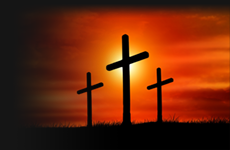Jesus' Crucifixion In Art
The symbol of Christ on the cross has infiltrated culture in innumerable ways, and depictions have become ubiquitous. There is no other subject matter that better reflects the historical progression of artistic expression. This is fitting, as there is no other event that has had comparable effect on all aspects of human history.

"The Crucifixion"
Artist: Jacob Cornelisz van Oostsanen
1500
Painting
In this Netherlandish depiction of the crucifixion, there is equal emphasis on the surrounding landscape and figures flanking the figure of Christ in the foreground, who are shown wearing contemporary dress. A woman with long red hair, Mary Magdalene, can be seen praying at Christ's feet.
A Dutch artist based in Amsterdam, Jacob Cornelisz van Oostanen (c.1475–1533) was later influenced by his contemporary Albrecht Dürer (1471–1528).

"The Mond Crucifixion"
Artist: Raphael
1502
Painting
Raphael's The Mond Crucifixion, painted between 1502 and 1503, includes an intricately detailed landscape in the background, showing his use of perspective, which distinguishes him from artists of the Trecento. Flanking him are two angels catching his blood in chalices, as well as the figures of the Virgin, Mary Magdalene, Saint Jerome and John the Evangelist. Raphael's signature is inscribed into the foot of Christ's cross.
- page 12 of 38 -
